
DIY kit
Ukulele
user manual

Musikhaus Thomann
Thomann GmbH
Hans-Thomann-Straße 1
96138 Burgebrach
Germany
Telephone: +49 (0) 9546 9223-0
E-mail: [email protected]
Internet: www.thomann.de
07.08.2018, ID: 327250 (V2)

Table of contents
1 Safety instruction................................................................................................................... 4
2 Scope of delivery..................................................................................................................... 5
3 Assembly instructions.......................................................................................................... 6
4 Protecting the environment........................................................................................... 12
Table of contents
DIY kit
3

1 Safety instruction
DANGER!
Danger for children
Ensure that plastic bags, packaging, etc. are properly disposed of and
are not in the reach of babies and young children. Choking hazard!
Ensure that children do not detach any small parts (e.g. knobs or the
like) from the product. They could swallow the pieces and choke!
Never let children play unattended with the product.
Safety instruction
Ukulele
4

2 Scope of delivery
Thank you for purchasing this Ukulele kit. In addition to this manual, the following
items are included:
1 Body
2 Neck
3 Fretboard
4 Saddle
5 Bridge
6 Nut
7 Fixing rings for machine heads (4 pcs.)
8 Machine heads (4 pcs.)
9 Mounting screws for machine heads (8 × short) and bridge (2 × long)
10 Strings (4 pcs.)
The assembly is described in detail in the following sections.
Scope of delivery
DIY kit
5

3 Assembly instructions
Provide the following tools and materials for the assembly of the Ukulele:
n Wood glue
n Phillips screwdriver
n Rubber bands
n Clamping or adhesive tape
n Gloss paints
n Sandpaper
Make sure when gluing that all adhesive surfaces are at and clean to
ensure an optimal connection of the individual parts.
Always follow the processing instructions supplied by the adhesive manu‐
facturer.
When applying spray paint, you must wear a dust mask.
Before assembling the Ukulele, you can paint the body with commercial wood paint
completely or decorate it with patterns. DIY stores oer a wide selection of paints
and varnishes in spray cans that can be applied without any special knowledge.
Before you start painting, carefully mask the adhesive surface for the bridge, as
painted surfaces do not ensure solid compound (for dimensions and position of the
bridge, see
Ä
‘Mounting the bridge, inserting the saddle’ on page 8).
Make sure that all surfaces are free of dust and dirt. Carry out all painting operations
in a well-ventilated, dust-free environment. Considered and careful working are key
factors for a qualitatively satisfactory result. It is recommended that you rst try out
the colour and technique on another piece of wood.
Paint the body edges rst and let them dry. If the edges are dry, go on with front and
back side. By layered, successive application you can achieve a uniform coating struc‐
ture. If you notice surface irregularities, wait until the paint has dried completely and
correct them with ne sandpaper (e.g. 800 +) before proceeding to paint. For full
coverage apply three or more layers. Wait another two to three days to dry until the
paint is fully cured. Polish or burnish the body until it meets your expectations. Make
sure that you polish not too strong and thus remove paint again.
Useful tools and materials
Finishing the body
Assembly instructions
Ukulele
6

The neck is fastened with a tongue and groove connection to the body. First, check
whether the connection between neck and body ts correctly. Wood slightly
changes its shape over time. If the neck sits too tight in the groove on the body, a
slight adjustment with a sharp wood chisel or sandpaper may be needed.
Apply wood glue to groove, tongue and the rest of the neck heel, which comes into
contact with the body. Position the neck on the body and x the neck with a
clamping or adhesive tape. Re-check the correct position of the neck to the body
before the glue joint has dried.
The fretboard is glued to the neck. Apply wood glue on both surfaces. Position the
fretboard on the neck and align it so that at the base of the headstock a 5 mm clear
space remains for mounting the nut. To dry the adhesive joint, x the fretboard with
rubber rings on the neck.
Glueing neck and body
Gluing the fretboard
Assembly instructions
DIY kit
7

The nut is to be glued above the fretboard on the neck (needed clearance between
fretboard and headstock 5 mm, see previous section). Apply wood glue on both sur‐
faces. Put the nut on the neck and x it to dry the adhesive joint with rubber rings on
the neck.
The bridge is to be glued and xed with the two long screws on the soundboard.
First mark the correct position of the bridge on the soundboard. Note the spacing
dimensions shown in the gure.
Apply wood glue on both surfaces. Put the bridge on the soundboard and x it to dry
the adhesive joint gently with a screw clamp.
NOTICE!
Tighten the clamp very carefully and only hand tight. Excessive force
may damage the soundboard.
Drill the two screw holes with a 1.5-mm wood drill by through the two blind holes in
the bridge and the soundbooard. Fix the bridge with the supplied long screws on the
soundboard. Then place the protective caps on the screw heads.
Finally, insert the saddle into the designated groove of the bridge.
Gluing the nut
Mounting the bridge, inserting the
saddle
Assembly instructions
Ukulele
8

Insert the four machine heads from the rear side into the headstock.
Fasten the four machine heads with two shorts screws each.
Press the four xing rings for the machine heads from the front into the respective
holes of the headstock.
Mounting the machine heads
Assembly instructions
DIY kit
9

The package includes a set of strings for the Hawaiian tuning (G - C - E - A). Tie a knot
at one end of the strings (simple knot for the two thicker strings, double knot for the
two thinner strings) and insert the strings into the grooves of the bridge as shown in
the gure:
n top position: G string (second thickest string)
n second position: C string (thickest string)
n third position: E string (second thinnest string)
n lowest position: A string (thinnest string)
Thread the loose ends of the four strings into the holes of the designated machine
heads. Make sure to attach each of the four strings with two to three turns securely to
the tuning pins (see gure). First, slightly pre-tighten all strings and check the action
as described in the following section.
Stringing the Ukulele
Assembly instructions
Ukulele
10

At the rst fret, the distance between string and fretboard should be approx. 0.4 mm,
at the twelfth fret approx. 1.2 mm. If necessary, check the connections and posi‐
tioning of the components.
The package includes a set of strings for the Hawaiian tuning (G - C - E - A). Tune the
strings using an appropriate tuner or with the help of another instrument by ear.
Checking the action
Tuning
Assembly instructions
DIY kit
11

4 Protecting the environment
For the transport and protective packaging, environmentally friendly materials have
been chosen that can be supplied to normal recycling.
Ensure that plastic bags, packaging, etc. are properly disposed of.
Do not just dispose of these materials with your normal household waste, but make
sure that they are collected for recycling. Please follow the notes and markings on
the packaging.
Disposal of the packaging material
Protecting the environment
Ukulele
12

Notes
DIY kit
13

Notes
Ukulele
14


Musikhaus Thomann · Hans-Thomann-Straße 1 · 96138 Burgebrach · Germany · www.thomann.de
-
 1
1
-
 2
2
-
 3
3
-
 4
4
-
 5
5
-
 6
6
-
 7
7
-
 8
8
-
 9
9
-
 10
10
-
 11
11
-
 12
12
-
 13
13
-
 14
14
-
 15
15
-
 16
16
Harley Benton Ukulele DIY-Kit Sopran User manual
- Type
- User manual
- This manual is also suitable for
Ask a question and I''ll find the answer in the document
Finding information in a document is now easier with AI
Related papers
-
Harley Benton Ukulele User manual
-
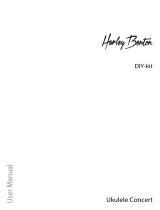 Harley Benton 490869 User manual
Harley Benton 490869 User manual
-
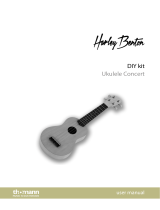 Harley Benton Ukulele DIY-Kit Concert User manual
Harley Benton Ukulele DIY-Kit Concert User manual
-
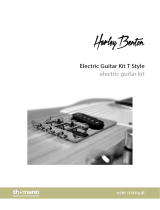 Harley Benton Electric Guitar Kit T-Style Owner's manual
Harley Benton Electric Guitar Kit T-Style Owner's manual
-
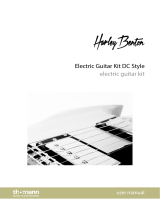 Harley Benton Electric Guitar Kit DC Style User manual
Harley Benton Electric Guitar Kit DC Style User manual
-
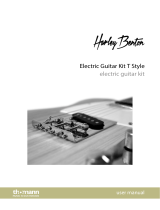 Harley Benton Electric Guitar Kit T-Style User manual
Harley Benton Electric Guitar Kit T-Style User manual
-
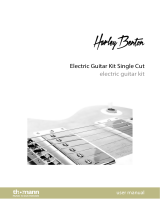 Harley Benton Electric Guitar Kit User manual
Harley Benton Electric Guitar Kit User manual
-
Harley Benton E-Gitarrenbausatz Single Cut User manual
-
 Harley Benton Electric Guitar Kit ST-Style Owner's manual
Harley Benton Electric Guitar Kit ST-Style Owner's manual
-
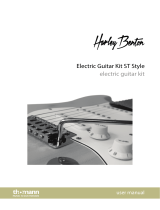 Harley Benton Electric Guitar Kit ST-Style User manual
Harley Benton Electric Guitar Kit ST-Style User manual
Other documents
-
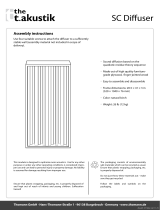 the t.akustik SC Diffusor Assembly Instructions
the t.akustik SC Diffusor Assembly Instructions
-
thomann DP-26/DP-28/SP-5600 Stand Assembly Instructions
-
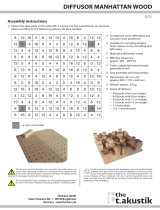 the t.akustik Diffusor Manhattan wood Assembly Instructions
the t.akustik Diffusor Manhattan wood Assembly Instructions
-
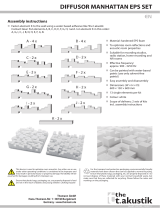 the t.akustik Diffusor Manhattan eps set Assembly Instructions
the t.akustik Diffusor Manhattan eps set Assembly Instructions
-
First Act none User manual
-
First Act Discovery Ukulele User manual
-
Pyle PUKT6580 Owner's manual
-
Pyle PUKT45 Owner's manual
-
thomann CTU-10 Ukulele Clip Tuner User guide
-
D ADDARIO Ukulele Operating instructions


























